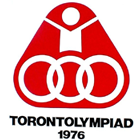TORONTO 1976 PARALYMPIC GAMES
While several countries withdrew from the 1976 Paralympic Games due to the participation of South Africa, amputees and vision impaired athletes were included in the programme for the first time ever. A total of 261 amputees and 187 vision impaired athletes took part in the Games.
Organising the sport classifications became more complicated, and it was becoming clear than an international body was needed to oversee and organise a multi-disability Paralympic Games.
The Games saw 1,271 Para athletes (1,000 men and 271 women) from 41 countries take part in 13 sports.
SPORTS
Thirteen different sports were showcased in Toronto, with a number of new sports added to showcase amputee and vision impaired athletes who could now participate in the Paralympic Games.
The sports were; archery, Para athletics, dartchery, goalball, shooting Para sport, snooker, Para swimming, table tennis, weightlifting, wheelchair basketball and wheelchair fencing.
OPENING CEREMONY
Nearly 24,000 spectators cheered on the athletes at the Woodbine racetrack during the Opening Ceremony on 3 August.
MEDALS
The medals prominently display the emblem of the Toronto 1976 Paralympic Games, along with the three interlocking wheels, the symbol of the International Stoke Mandeville Wheelchair Sports Federation.
Design Elements of the Medals
The Toronto 1976 Paralympic Games emblem was showcased on both sides of the medal. One side has the emblem in the centre with the name of the Games, “Torontolympiad - 1976 Olympiad for the Physically Disabled”. The other side has braille engravings that read “1976 Toronto Olympiad” and a motif of six petals coming together in a central hexagon, with each of the petals displaying three interlocking wheels. The phrase “Everyone Wins” is written on the medals.
OUTSTANDING PERFORMANCES
Canadian Arnie Boldt, an 18-year-old single-leg amputee gave a memorable performance, underlining the first time amputee athletes participated in the Games. He won the high jump with a 1.86m jump and the long jump with a mark of 2.96m.
US wheelchair racer David Kiley set a new world record in the 100m dash with a time of 19 seconds. He then set a new world record in the 800m with a time of 2:47 minutes and the 1,500m with a time of 5:32 minutes. He was also a member of the USA’s wheelchair basketball squad that defeated Israel in the gold medal match.
As a nation, the Netherlands demonstrated its strength in the pool, taking home 36 gold medals in swimming.
ATTENDANCE AND COVERAGE
Because suitable lodging could not be arranged in the immediate area of events, school buses were hired and loading docks were constructed to transport the athletes from the event venues to their accommodations.
For the first time, television coverage of the Paralympics was broadcast daily to more than 600,000 viewers in the Southern Ontario area. This was a major breakthrough for the Paralympic Movement.
CLOSING CEREMONY
The Closing Ceremony that ended the colourful nine-day event, held on 11 August, took place at the Centennial Park Stadium before a crowd of 5,000 spectators.

 Facebook
Facebook
 Instagram
Instagram
 Twitter
Twitter
 Youtube
Youtube
 TikTok
TikTok
 Newsletter Subscribe
Newsletter Subscribe
